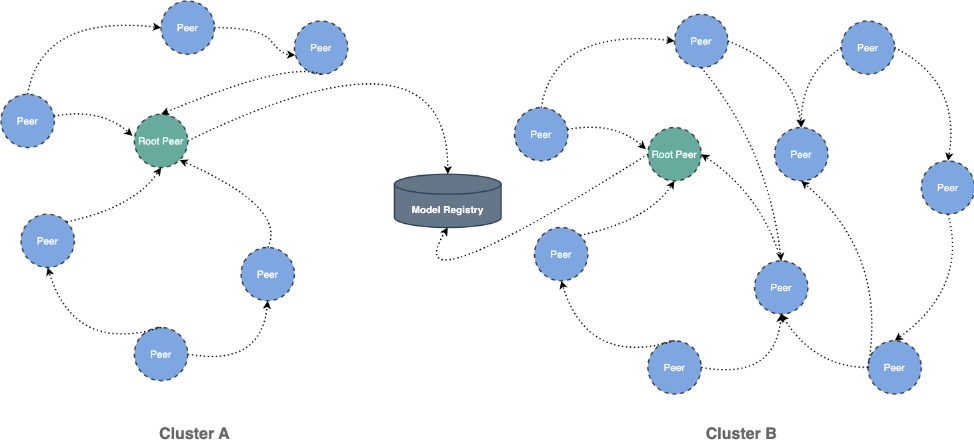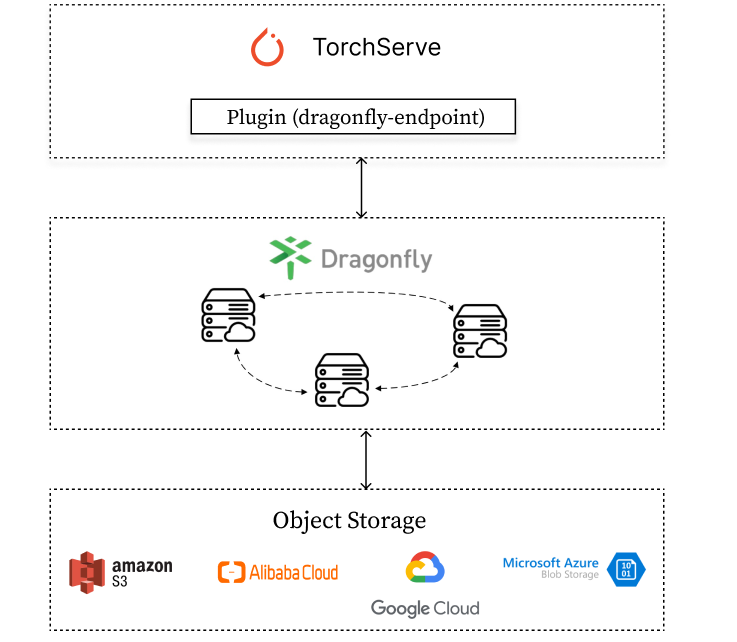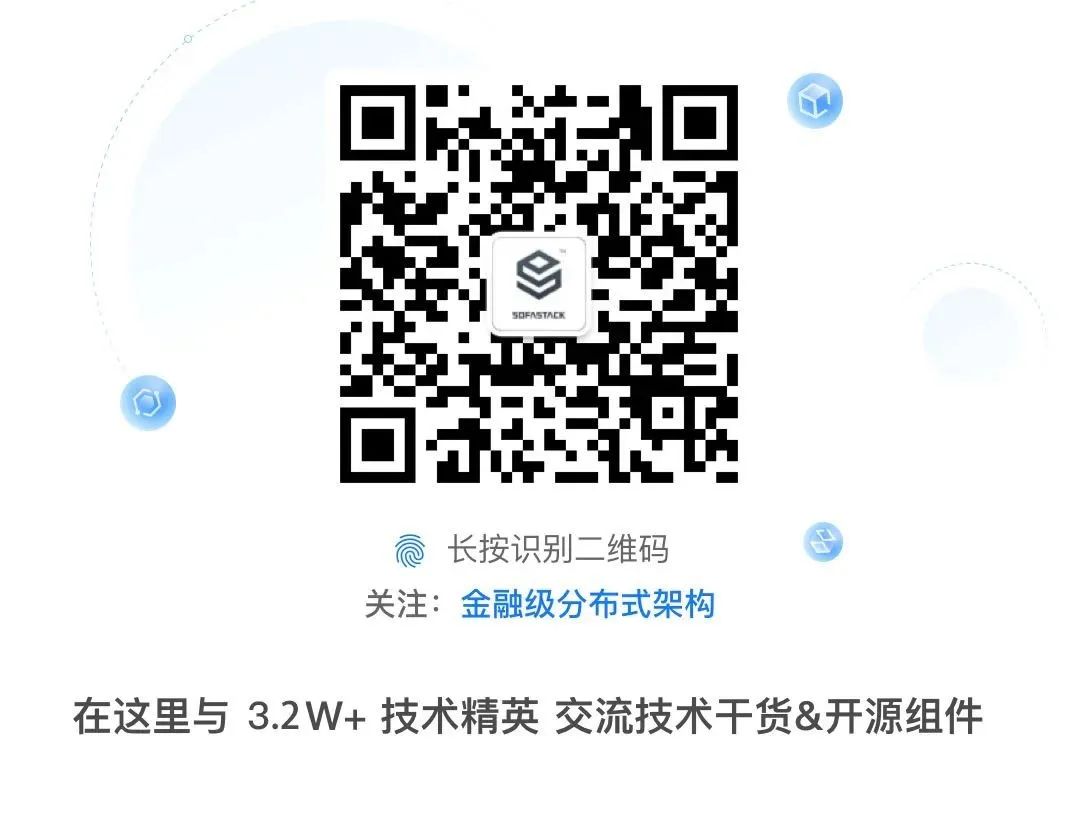
Dragonfly GitHub:
https://github.com/dragonflyoss/Dragonfly2
本文主要解决在 TorchServe 模型拉取时,存在的中心化的模型仓库带宽瓶颈问题。当在 TorchServe 下载模型的时候,文件相对较大且会有并发下载模型的场景。这样很容易导致存储带宽被打满,从而引起下载过慢的情况,影响推理服务的使用。

这种方式比较好的解决方案是使用 Dragonfly 的 P2P 技术利用每个节点的闲置带宽缓解模型仓库的带宽压力,从而达到加速效果。在最理想的情况下 Dragonfly 可以让整个 P2P 集群中只有一个节点回源下载模型,其他节点流量均使用集群内 P2P 内网带宽。

Part 1. 架构

TorchServe 通过集成 Dragonfly Endpoint 插件,发送模型下载请求到 Dragonfly,Dragonfly 作为代理去对应的 Object Storage 下载模型并返回。

模型下载步骤:
1.TorchServe 发起模型下载请求到 Dragonfly Peer。
2.Dragonfly Peer 会到 Dragonfly Scheduler 注册任务。
3.返回合适的一组父节点给 Dragonfly Peer 进行下载。
4.Dragonfly Peer 从合适的一组父节点分片下载文件。
5.模型下载完成之后,TorchServe 会进行模型注册。
Part 2. 部署
通过集成 Dragonfly Endpoint 到 TorchServe 中,使下载流量通过 Dragonfly 去拉取 S3,OSS,GCS,ABS 中存储的模型文件, 并在 TorchServe 中进行注册。TorchServe 插件维护在 dragonfly-endpoint 仓库中。
2.1 依赖

注意:如果没有可用的 Kubernetes 集群进行测试,推荐使用 Kind。
2.2 Dragonfly Kubernetes 集群搭建
基于 Kubernetes cluster 详细安装文档可以参考 quick-start-kubernetes[1]。
‣ 准备 Kubernetes 集群
创建 Kind 多节点集群配置文件 kind-config.yaml,配置如下:
kind: Cluster
apiVersion: kind.x-k8s.io/v1alpha4
nodes:
- role: control-plane
- role: worker
- role: worker使用配置文件创建 Kind 集群:
kind create cluster --config kind-config.yaml切换 Kubectl 的 context 到 Kind 集群:
kubectl config use-context kind-kind‣ Kind 加载 Dragonfly 镜像
下载 Dragonfly Latest 镜像:
docker pull dragonflyoss/scheduler:latest
docker pull dragonflyoss/manager:latest
docker pull dragonflyoss/dfdaemon:latestKind 集群加载 Dragonfly Latest 镜像:
kind load docker-image dragonflyoss/scheduler:latest
kind load docker-image dragonflyoss/manager:latest
kind load docker-image dragonflyoss/dfdaemon:latest‣ 基于 Helm Charts 创建 Dragonfly 集群
创建 Helm Charts 配置文件 charts-config.yaml。可以根据对象存储的下载路径修改 dfdaemon.config.proxies.regx 来调整路由匹配规则,示例中默认匹配了 AWS S3 的请求,配置如下:
scheduler:
image: dragonflyoss/scheduler
tag: latest
replicas: 1
metrics:
enable: true
config:
verbose: true
pprofPort: 18066
seedPeer:
image: dragonflyoss/dfdaemon
tag: latest
replicas: 1
metrics:
enable: true
config:
verbose: true
pprofPort: 18066
dfdaemon:
image: dragonflyoss/dfdaemon
tag: latest
metrics:
enable: true
config:
verbose: true
pprofPort: 18066
proxy:
defaultFilter: "Expires&Signature&ns"
security:
insecure: true
cacert: ""
cert: ""
key: ""
tcpListen:
namespace: ""
port: 65001
registryMirror:
url: https://index.docker.io
insecure: true
certs: []
direct: false
proxies:
- regx: blobs/sha256.*
- regx: .*amazonaws.*
manager:
image: dragonflyoss/manager
tag: latest
replicas: 1
metrics:
enable: true
config:
verbose: true
pprofPort: 18066
jaeger:
enable: true使用配置文件部署 Dragonfly Helm Charts:
$ helm repo add dragonfly https://dragonflyoss.github.io/helm-charts/
$ helm install --wait --create-namespace --namespace dragonfly-system dragonfly dragonfly/dragonfly -f charts-config.yaml
LAST DEPLOYED: Mon Sep 4 10:24:55 2023
NAMESPACE: dragonfly-system
STATUS: deployed
REVISION: 1
TEST SUITE: None
NOTES:
1. Get the scheduler address by running these commands:
export SCHEDULER_POD_NAME=$(kubectl get pods --namespace dragonfly-system -l "app=dragonfly,release=dragonfly,component=scheduler" -o jsonpath={.items[0].metadata.name})
export SCHEDULER_CONTAINER_PORT=$(kubectl get pod --namespace dragonfly-system $SCHEDULER_POD_NAME -o jsonpath="{.spec.containers[0].ports[0].containerPort}")
kubectl --namespace dragonfly-system port-forward $SCHEDULER_POD_NAME 8002:$SCHEDULER_CONTAINER_PORT
echo "Visit http://127.0.0.1:8002 to use your scheduler"
2. Get the dfdaemon port by running these commands:
export DFDAEMON_POD_NAME=$(kubectl get pods --namespace dragonfly-system -l "app=dragonfly,release=dragonfly,component=dfdaemon" -o jsonpath={.items[0].metadata.name})
export DFDAEMON_CONTAINER_PORT=$(kubectl get pod --namespace dragonfly-system $DFDAEMON_POD_NAME -o jsonpath="{.spec.containers[0].ports[0].containerPort}")
You can use $DFDAEMON_CONTAINER_PORT as a proxy port in Node.
3. Configure runtime to use dragonfly:
https://d7y.io/docs/getting-started/quick-start/kubernetes/
4. Get Jaeger query URL by running these commands:
export JAEGER_QUERY_PORT=$(kubectl --namespace dragonfly-system get services dragonfly-jaeger-query -o jsonpath="{.spec.ports[0].port}")
kubectl --namespace dragonfly-system port-forward service/dragonfly-jaeger-query 16686:$JAEGER_QUERY_PORT
echo "Visit http://127.0.0.1:16686/search?limit=20&lookback=1h&maxDuration&minDuration&service=dragonfly to query download events"检查 Dragonfly 是否部署成功:
$ kubectl get po -n dragonfly-system
NAME READY STATUS RESTARTS AGE
dragonfly-dfdaemon-7r2cn 1/1 Running 0 3m31s
dragonfly-dfdaemon-fktl4 1/1 Running 0 3m31s
dragonfly-jaeger-c7947b579-2xk44 1/1 Running 0 3m31s
dragonfly-manager-5d4f444c6c-wq8d8 1/1 Running 0 3m31s
dragonfly-mysql-0 1/1 Running 0 3m31s
dragonfly-redis-master-0 1/1 Running 0 3m31s
dragonfly-redis-replicas-0 1/1 Running 0 3m31s
dragonfly-redis-replicas-1 1/1 Running 0 3m5s
dragonfly-redis-replicas-2 1/1 Running 0 2m44s
dragonfly-scheduler-0 1/1 Running 0 3m31s
dragonfly-seed-peer-0 1/1 Running 0 3m31s‣ 暴露 Proxy 服务端口
创建 dfstore.yaml 配置文件,暴露 Dragonfly Peer 的 HTTP Proxy 服务监听的端口,用于和 TorchServe 交互。targetPort 如果未在 charts-config.yaml 中修改默认为 65001, port 可根据实际情况设定值,建议也使用 65001。
kind: Service
apiVersion: v1
metadata:
name: dfstore
spec:
selector:
app: dragonfly
component: dfdaemon
release: dragonfly
ports:
- protocol: TCP
port: 65001
targetPort: 65001
type: NodePort创建 Service:
kubectl --namespace dragonfly-system apply -f dfstore.yaml将本地的 65001 端口流量转发至 Dragonfly 的 Proxy 服务:
kubectl --namespace dragonfly-system port-forward service/dfstore 65001:650012.3 安装 Dragonfly Endpoint 插件
‣ 设置 Dragonfly Endpoint 配置的环境变量
创建 config.json 配置文件,并将 DRAGONFLY_ENDPOINT_CONFIG 环境变量配置为 config.json 文件路径。
export DRAGONFLY_ENDPOINT_CONFIG=/etc/dragonfly-endpoint/config.json默认读取路径为:
Linux:
/etc/dragonfly-endpoint/config.json
Darwin:
~/.dragonfly-endpoint/config.json
‣ Dragonfly Endpoint 插件配置
创建 config.json 配置文件,对 Torchserve 插件进行配置。下面是 S3 的配置:
{
"addr": "http://127.0.0.1:65001",
"header": {
},
"filter": [
"X-Amz-Algorithm",
"X-Amz-Credential",
"X-Amz-Date",
"X-Amz-Expires",
"X-Amz-SignedHeaders",
"X-Amz-Signature"
],
"object_storage": {
"type": "s3",
"bucket_name": "your_s3_bucket_name",
"region": "your_s3_access_key",
"access_key": "your_s3_access_key",
"secret_key": "your_s3_access_key"
}
}addr: Drangonfly 的 Peer 的 HTTP Proxy 的地址。
header: 为请求增加请求头。
filter: 用于生成唯一的任务,并过滤 URL 中不必要的查询参数。
object_storage: 模型文件所在对象存储的配置,其中 type 可为 s3,oss,abs,gcs,具体参考对象存储配置。
配置文件中的 filter 部分, 根据对象存储类型设置不同值:

对象存储配置
除 S3 外,Dragonfly 的 TorchServe 插件还支持 OSS,GCS,ABS。不同的对象存储配置如下:
OSS(Object Storage Service)
{
"addr": "http://127.0.0.1:65001",
"header": {},
"filter": ["Expires", "Signature"],
"object_storage": {
"type": "oss",
"bucket_name": "your_oss_bucket_name",
"endpoint": "your_oss_endpoint",
"access_key_id": "your_oss_access_key_id",
"access_key_secret": "your_oss_access_key_secret"
}
}GCS(Google Cloud Storage)
"addr": "http://127.0.0.1:65001",
"header": {},
"object_storage": {
"type": "gcs",
"bucket_name": "your_gcs_bucket_name",
"project_id": "your_gcs_project_id",
"service_account_path": "your_gcs_service_account_path"
}
}ABS(Azure Blob Storage)
{
"addr": "http://127.0.0.1:65001",
"header": {},
"object_storage": {
"type": "abs",
"account_name": "your_abs_account_name",
"account_key": "your_abs_account_key",
"container_name": "your_abs_container_name"
}
}2.4 TorchServe 集成 Dragonfly Endpoint 插件
TorchServe 在不同生产环境下使用的具体文档可参考 TorchServe 文档[2]。以下提供二种部署方式, 推荐使用 Docker 容器化部署:
部署方案一:二进制安装
依赖:

安装 TorchServe 依赖和 torch-model-archiver:
git clone https://github.com/pytorch/serve.git
cd serve克隆 TorchServe 存储库:
git clone https://github.com/pytorch/serve.git
cd serve创建 model-store 目录用来存储模型文件:
mkdir model-store
chmod 777 model-store创建 plugins-path 目录用来存储插件的二进制文件:
mkdir plugins-path‣ 打包 Dragonfly Endpoint 插件
下载 dragonfly-endpoint 项目:
git clone https://github.com/dragonflyoss/dragonfly-endpoint.git打包 dragonfly-endpoint 项目,在 build/libs 目录下生成文件:
cd ./dragonfly-endpoint
gradle shadowJar注意:因为 TorchServe 自身 JVM 的限制,Gradle 的 Java 版本号最好为 11,版本号过高会导致插件无法解析。
将 Jar 文件放入之前创建好的 plugins-path 目录下:
mv build/libs/dragonfly_endpoint-1.0-all.jar <your plugins-path>准备插件的配置文件 config.json,对象存储仍以 S3 为例:
{
"addr": "http://127.0.0.1:65001",
"header": {
},
"filter": [
"X-Amz-Algorithm",
"X-Amz-Credential",
"X-Amz-Date",
"X-Amz-Expires",
"X-Amz-SignedHeaders",
"X-Amz-Signature"
],
"object_storage": {
"type": "s3",
"bucket_name": "your_s3_bucket_name",
"region": "your_s3_access_key",
"access_key": "your_s3_access_key",
"secret_key": "your_s3_access_key"
}
}设置配置文件的环境变量:
export DRAGONFLY_ENDPOINT_CONFIG=/etc/dragonfly-endpoint/config.json--model-store 使用之前创建的存储模型目录,--plugins-path 使用之前创建的存储插件的目录。启动 TorchServe 使用 Dragonfly Endpoint 插件 :
torchserve --start --model-store <path-to-model-store-file> --plugins-path=<path-to-plugin-jars>‣ 功能验证
准备模型文件。请直接到 Model ZOO [3] 中下载现成的模型文件 .mar 或者参考 Torch Model archiver for TorchServe [4] 打包自己模型文件。
以 squeezenet1_1_scripted.mar 模型为例:
wget https://torchserve.pytorch.org/mar_files/squeezenet1_1_scripted.mar上传模型到对象存储,以下以 S3 为例,具体参考 S3:
# 下载命令行工具
pip install awscli
# 根据提示配置密钥等
aws configure
# 上传文件
aws s3 cp <本地文件路径> s3://<存储桶名称>/<目标路径>TorchServe 插件名称为 dragonfly,插件 API 的详细参数请参考 TorchServe Register API,不支持 url 参数,并增加参数 file_name 参数 ,即需要下载的模型文件名称。
发送下载请求进行测试:
curl -X POST "http://localhost:8081/dragonfly/models?file_name=squeezenet1_1.mar"正确响应:
{
"Status": "Model "squeezenet1_1" Version: 1.0 registered with 0 initial workers. Use scale workers API to add workers for the model."
}增加模型的 Worker 用于推理:
curl -v -X PUT "http://localhost:8081/models/squeezenet1_1?min_worker=1"模型的 Worker 数量增加成功,响应如下:
* About to connect() to localhost port 8081 (#0)
* Trying ::1...
* Connected to localhost (::1) port 8081 (#0)
> PUT /models/squeezenet1_1?min_worker=1 HTTP/1.1
> User-Agent: curl/7.29.0
> Host: localhost:8081
> Accept: */*
>
< HTTP/1.1 202 Accepted
< content-type: application/json
< x-request-id: 66761b5a-54a7-4626-9aa4-12041e0e4e63
< Pragma: no-cache
< Cache-Control: no-cache; no-store, must-revalidate, private
< Expires: Thu, 01 Jan 1970 00:00:00 UTC
< content-length: 47
< connection: keep-alive
<
{
"status": "Processing worker updates..."
}
* Connection #0 to host localhost left intact调用推理 API:
# 准备需要推理的图片
curl -O https://raw.githubusercontent.com/pytorch/serve/master/docs/images/kitten_small.jpg
curl -O https://raw.githubusercontent.com/pytorch/serve/master/docs/images/dogs-before.jpg
# 调用推理 API
curl http://localhost:8080/predictions/squeezenet1_1 -T kitten_small.jpg -T dogs-before.jpg推理 API 成功调用后的响应:
{
"lynx": 0.5455784201622009,
"tabby": 0.2794168293476105,
"Egyptian_cat": 0.10391931980848312,
"tiger_cat": 0.062633216381073,
"leopard": 0.005019133910536766
}部署方案二:Docker 部署 TorchServe
‣ Docker 配置
拉取自带插件的 dragonflyoss/dragonfly-endpoint 镜像。以下为 CPU 版的 TorchServe 为例子。构建细节参考 Dockerfile [5]。
docker pull dragonflyoss/dragonfly-endpoint创建 model-store 目录用来存储模型文件:
mkdir model-store
chmod 777 model-store准备插件的配置文件 config.json,对象存储仍以 S3 为例:
{
"addr": "http://127.0.0.1:65001",
"header": {
},
"filter": [
"X-Amz-Algorithm",
"X-Amz-Credential&X-Amz-Date",
"X-Amz-Expires",
"X-Amz-SignedHeaders",
"X-Amz-Signature"
],
"object_storage": {
"type": "s3",
"bucket_name": "your_s3_bucket_name",
"region": "your_s3_access_key",
"access_key": "your_s3_access_key",
"secret_key": "your_s3_access_key"
}
}设置配置文件的环境变量:
export DRAGONFLY_ENDPOINT_CONFIG=/etc/dragonfly-endpoint/config.json运行容器并 mount model-store 和 dragonfly-endpoint 配置目录:
# 使用环境变量的配置路径
sudo docker run --rm -it --network host -v $(pwd)/model-store:/home/model-server/model-store -v ${DRAGONFLY_ENDPOINT_CONFIG}:${DRAGONFLY_ENDPOINT_CONFIG} dragonflyoss/dragonfly-endpoint:latest‣ 功能验证
准备模型文件。请直接到 Model ZOO 中下载现成的模型文件 .mar 或者参考 Torch Model archiver for TorchServe 打包自己模型文件。
以 squeezenet1_1_scripted.mar 模型为例:
wget https://torchserve.pytorch.org/mar_files/squeezenet1_1_scripted.mar上传模型到对象存储,以下以 S3 为例,具体参考 S3:
# 下载命令行工具
pip install awscli
# 根据提示配置密钥等
aws configure
# 上传文件
aws s3 cp <本地文件路径> s3://<存储桶名称>/<目标路径>TorchServe 插件名称为 dragonfly,在 TorchServe 的管理接口下监听。插件 API 的详细参数请参考 TorchServe Register API [6] (仅不支持 url 参数),并增加参数 file_name ,即需要下载的模型文件。
发送下载请求进行测试:
curl -X POST "http://localhost:8081/dragonfly/models?file_name=squeezenet1_1.mar"正确响应:
{
"Status": "Model "squeezenet1_1" Version: 1.0 registered with 0 initial workers. Use scale workers API to add workers for the model."
}增加模型的 Worker 用于推理:
curl -v -X PUT "http://localhost:8081/models/squeezenet1_1?min_worker=1"模型的 Worker 数量增加成功,响应如下:
* About to connect() to localhost port 8081 (#0)
* Trying ::1...
* Connected to localhost (::1) port 8081 (#0)
> PUT /models/squeezenet1_1?min_worker=1 HTTP/1.1
> User-Agent: curl/7.29.0
> Host: localhost:8081
> Accept: */*
>
< HTTP/1.1 202 Accepted
< content-type: application/json
< x-request-id: 66761b5a-54a7-4626-9aa4-12041e0e4e63
< Pragma: no-cache
< Cache-Control: no-cache; no-store, must-revalidate, private
< Expires: Thu, 01 Jan 1970 00:00:00 UTC
< content-length: 47
< connection: keep-alive
<
{
"status": "Processing worker updates..."
}
* Connection #0 to host localhost left intact调用推理 API:
# 准备需要推理的图片
curl -O https://raw.githubusercontent.com/pytorch/serve/master/docs/images/kitten_small.jpg
curl -O https://raw.githubusercontent.com/pytorch/serve/master/docs/images/dogs-before.jpg
# 调用推理 API
curl http://localhost:8080/predictions/squeezenet1_1 -T kitten_small.jpg -T dogs-before.jpg推理 API 成功调用后的响应:
{
"lynx": 0.5455784201622009,
"tabby": 0.2794168293476105,
"Egyptian_cat": 0.10391931980848312,
"tiger_cat": 0.062633216381073,
"leopard": 0.005019133910536766
}‣ 性能测试
测试在单机情况下,集成 Dragonfly 后下载模型的性能对比。使用的对象存储是 OSS,由于机器本身网络环境、配置等影响,实际下载时间不具有参考价值。不同场景下下载速度对应的比例较有意义。

TorchServe API: 直接通过 URL 下载对象存储里的模型文件。
TorchServe API & Dragonfly Cold Boot:通过 Dragonfly 代理模式进行回源下载,没有命中任何缓存所花费的时间。
Hit Remote Peer: 通过 Dragonfly 代理模式,在命中 Dragonfly 的远端 Peer 缓存的情况下的下载时间。
Hit Local Peer: 通过 Dragonfly 代理模式,在命中 Dragonfly 的本地 Peer 缓存的情况下的下载时间。
测试结果表明 TorchServe 集成 Dragonfly,能有效减少下载时间。在命中缓存 ,尤其是本地缓存的情况下有较大的提升。即使是回源下载的性能也和直接下载的相差无几。注意的是本次测试为单机测试,意味着在命中缓存的情况下,性能瓶颈主要在磁盘。如果是多台机器部署的 Dragonfly 进行 P2P 下载的情况,模型下载速度会更快。
Part 3. 相关链接
文章链接
[1].quick-start-kubernetes:
https://d7y.io/zh/docs/getting-started/quick-start/kubernetes/
[2].TorchServe 文档:
https://pytorch.org/serve/
[3].Model ZOO:
https://pytorch.org/serve/model_zoo.html#
[4].Torch Model archiver for TorchServe:
https://github.com/pytorch/serve/tree/master/model-archiver
[5].Dockerfile:
https://github.com/dragonflyoss/dragonfly-endpoint/blob/main/images/Dockerfile
[6].TorchServe Register API:
https://pytorch.org/serve/management_api.html#register-a-model
Dragonfly 社区
Website:
https://d7y.io/
Github Repo:
https://github.com/dragonflyoss/Dragonfly2
Dragonfly Endpoint Github Repo:
https://github.com/dragonflyoss/dragonfly-endpoint
Slack Channel:
#dragonfly on CNCF Slack
Discussion Group:
dragonfly-discuss@googlegroups.com
Twitter:
@dragonfly_oss
Pytorch
Website:
https://pytorch.org/
Github Repo:
https://github.com/pytorch/pytorch
TorchServe Document:
https://pytorch.org/serve/
TorchServe Github Repo:
https://github.com/pytorch/serve

【Dragonfly Github 仓库】二维码
本周推荐阅读
Nydus Acceld 去 Containerd 服务化
与 Harbor 构建高效的镜像加速工作流
Seata Saga 模式快速入门和最佳实践
Seata-DTX|分布式事务金融场景案例介绍

























 1382
1382

 被折叠的 条评论
为什么被折叠?
被折叠的 条评论
为什么被折叠?








